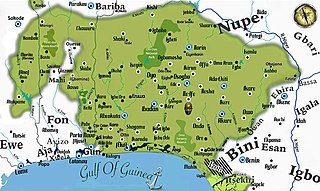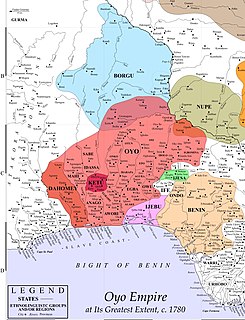
The demographics of Togo include ethnicity, population density, age, education level, health, economic status and religious affiliation.

The demographics of Benin include population density, ethnicity, education level, health of the populace, economic status, religious affiliations and other aspects of the population.

Oduduwa was a Yoruba divine king. and a great yoruba ancestor. According to tradition, he was the holder of the title of the Olofin of Ile-Ife, the Yoruba holy city. He ruled briefly in Ife, and also served as the progenitor of a number of independent royal dynasties in Yorubaland. His name, phonetically written by Yoruba language speakers as Odùduwà and sometimes contracted as Ooduwa, Odudua or Oòdua, is today venerated as that of "the hero, the warrior, the leader and father of the Yoruba race". Through conflict and mostly, through diplomacy lasting many years, Oduduwa was able to temporarily usurp the throne of Ife to become King.

Orishas are spirits that play a key role in the Yoruba religion of West Africa and several religions of the African diaspora that derive from it, such as Cuban, Dominican and Puerto Rican Santería and Brazilian Candomblé. The preferred spelling varies depending on the language in question: òrìṣà is the spelling in the Yoruba language, orixá in Portuguese, and orisha, oricha, orichá or orixá in Spanish-speaking countries,

Ifẹ̀ is an ancient Yoruba city in south-western Nigeria. The city is located in present-day Osun State. Ife is about 218 kilometers northeast of Lagos with a population of 509,813, the highest in Osun State according to population census of 2006.
Ifá is a Yoruba religion and system of divination. Its literary corpus is the Odu Ifá. Orunmila is identified as the Grand Priest, as he is who revealed divinity and prophecy to the world. Babalawos or Iyanifas use either the divining chain known as Opele, or the sacred palm or kola nuts called Ikin, on the wooden divination tray called Opon Ifá.

The Yoruba religion, or Isese, comprises the traditional religious and spiritual concepts and practice of the Yoruba people. Its homeland is in present-day Southwestern Nigeria, which comprises the majority of Oyo, Ogun, Osun, Ondo, Ekiti, Kwara and Lagos States, as well as parts of Kogi state and the adjoining parts of Benin and Togo, commonly known as Yoruba land. It shares some parallels with the Vodun practiced by the neighboring Fon and Ewe peoples to the west and to the religion of the Edo people to the east. Yoruba religion is the basis for a number of religions in the New World, notably Santería, Umbanda, Trinidad Orisha, Haitian Vodou, and Candomblé. Yoruba religious beliefs are part of Itàn (history), the total complex of songs, histories, stories, and other cultural concepts which make up the Yoruba society.
The Aja also spelled Adja are an ethnic group native to south-western Benin and south-eastern Togo. According to oral tradition, the Aja migrated to southern Benin in the 12th or 13th centuries from Tado on the Mono River, and c. 1600, three brothers, Kokpon, Do-Aklin, and Te-Agbanlin, split the ruling of the region then occupied by the Aja amongst themselves: Kokpon took the capital city of Great Ardra, reigning over the Allada kingdom; Do-Aklin founded Abomey, which would become capital of the Kingdom of Dahomey; and Te-Agbanlin founded Little Ardra, also known as Ajatche, later called Porto Novo by Portuguese traders and the current capital city of Benin.

Yorubaland is the homeland and cultural region of the Yoruba people in West Africa. It spans the modern-day countries of Nigeria, Togo and Benin, and covers a total land area of 142,114 km2. Of this, 106,016 km2 (74.6%) lies within Nigeria, 18.9% in Benin, and the remaining 6.5% is in Togo. Prior to European colonization, a portion of this area was known as Yoruba country. The geocultural space contains an estimated 55 million people, the overwhelming majority of this population being ethnic Yorubas.

Atakpamé is the fifth largest city in Togo by population, located in the Plateaux Region of Togo. It is an industrial centre and lies on the main north-south highway, 161 km north of the capital Lomé. It is also a regional commercial centre for produce and cloth.

The Oyo Empire was a powerful Yoruba empire of West Africa made up of parts of present-day eastern Benin and western Nigeria. It grew to become the largest Yoruba-speaking state and rose through the outstanding organizational and administrative skills of the Yoruba people, wealth gained from trade, and a powerful cavalry. The Oyo Empire was one of the most politically important states in the entirety of Western Africa from the mid-17th to the late 18th century, and held sway not only over most of the other kingdoms in Yorubaland, but also over nearby African states, notably the Fon Kingdom of Dahomey in the modern Republic of Benin on its west.

The Ewe people are a Gbe ethnic group. The largest population of Ewe people is in Ghana, and the second largest population in Togo. They speak the Ewe language which belongs to the Gbe family of languages. They are related to other speakers of Gbe languages such as the Fon, Gen, Phla Phera, Gun, Maxi, and the Aja people of Togo, Benin and southwestern Nigeria.
Notsé is a town in the Plateaux Region of Togo. It is the capital of Haho Prefecture and is situated 95 km north of the capital Lomé. The town was formed around 1600 by the Ewe people, after they were displaced westward by the expansion of the Yoruba.

The documented history begins when Oranyan came to rule the Oyo Empire, which became dominant in the early 17th century. The older traditions of the formerly dominant Ile-Ife kingdom are largely oral in nature.

The Yoruba of West Africa are responsible for one of the finest artistic traditions in Africa, a tradition that remains vital and influential today.

The Yoruba people are a West African ethnic group that mainly inhabits parts of Nigeria, Benin and Togo that constitute Yorubaland. The Yorubas constitute more than 46 million people in Africa, are a few hundred thousand outside the continent, and bear further representation among members of the African diaspora. The vast majority of the Yoruba population is today within the country of Nigeria, where they make up 15.5% of the country's population according to CIA estimations, making them one of the largest ethnic groups in Africa. Most Yoruba people speak the Yoruba language, which is the Niger-Congo language with the largest number of native or L1 speakers.
The Itsekiri language is a major branch of the Yoruboid group of languages, which as a group, is a key member of the Volta–Niger sub-family of the Niger–Congo family of African languages. Itsekiri is spoken by nearly 900,000 people in Nigeria as a first language and by many others as an additional language notably in the Niger Delta and in parts of Edo and Ondo states of Nigeria. The other key members of the Yoruboid group are Yoruba and Igala along with the various Yoruba dialects spoken in Benin and Togo.
Yoruba Americans are Americans of Yoruba descent. The Yoruba people are a West African ethnic group that predominantly inhabits southwestern Nigeria, with smaller indigenous communities in Benin and Togo.

Yoruba Canadians are Canadians of Yoruba descent. The Yoruba people are an ethnic group of southwestern Nigeria and southern Benin in West Africa. They represent the largest ethnic community of Nigerians in Canada. According to the 2016 Canadian census by Statistics Canada, 16,210 respondents spoke Yoruba at home. But exact population estimates for Yoruba-Canadians are most likely far greater, because many would have simply identified as Nigerian or Beninese only or reported just English as home language. The earliest Yoruba settlers in Canada were descendants of slaves transported to North America, Latin America and the Caribbean through the Atlantic slave trade. This resulted in a sizable proportion of Yoruba Canadians descending from African American slaves while recent migrants come directly from West Africa.

The Isha sometimes spelt Ica, and Itcha are a relatively small group of the Yoruba people, situated in the western parts of middle Benin, West Africa, especially in the town of Bantè and other surrounding communities in the Collines Department.












